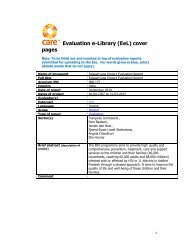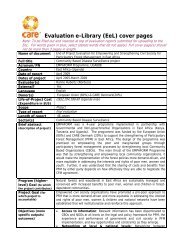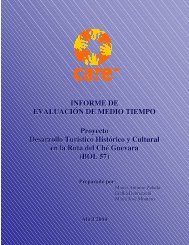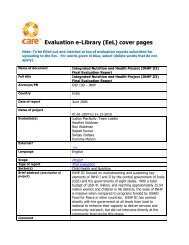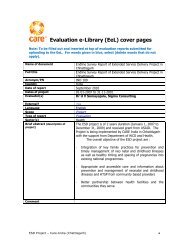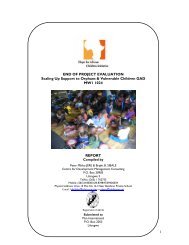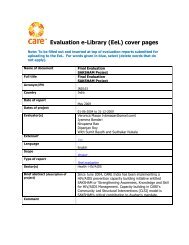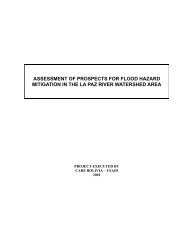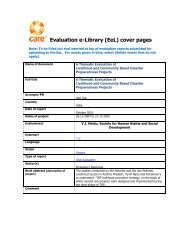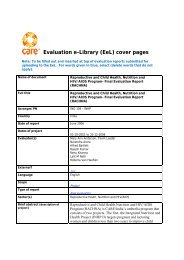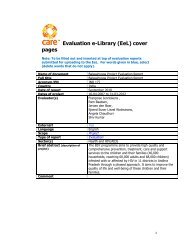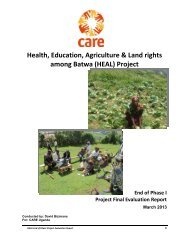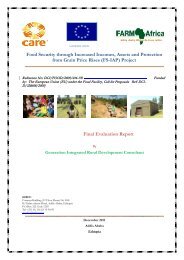IND 199 ECDE Baseline - CARE International's Electronic ...
IND 199 ECDE Baseline - CARE International's Electronic ...
IND 199 ECDE Baseline - CARE International's Electronic ...
- No tags were found...
You also want an ePaper? Increase the reach of your titles
YUMPU automatically turns print PDFs into web optimized ePapers that Google loves.
lxxivtheir profile, working experience and training received to work as AWW. The AWWs wereinterviewed to collect information on their knowledge of the activities she performs and onfunctioning of the AWCs; focus was on the information related to the growth anddevelopment of children.86 8.1 Background characteristics of AWWs8.1.1 Profile of AWWsA total of 181 AWWs could be interviewed against a target 186 (62 in each district). Abouthalf of the surveyed AWWs were in age group of 30-39 years (64% in intervention , 51% inintermediate and 33% in control AWCs) . Their mean age was around 37 years. Around three– fifths of them had completed at least high school education and all of them except onewere Hindu. Almost 95 percent of AWWs belonged to SC/ST (49%) or other background class(46%). About 88 percent were currently married, 6 percent were widowed / divorced /separated and 7 percent were never married. For more details, Table 8.1A in Annexure -2may be referred.8.1.2 Working experienceMore than three – fifths of AWWs in intervention districts had been working as AWW for morethan 10 years, while 59 percent in control district had been there in this position for less than6 years. Only 15 AWWs worked as sahayika before joining as an AWW (Table 8.2A inAnnexure -2).8.1.3 Training statusAll except one in Raigarh reported to have received training to work as AWW. All of themhave received institutional training with practical & mock sessions, while 94 percent reportedto have received training an supervised practice at AWC and community. Average duration ofthe training was about 25 days including 21 days for institutional training with practical &mock sessions and 4 days for supervised practice at the AWC & community.About three – fourths of them reported involvement of CDPO and ICDS supervisor inimparting training to them, while involvement of any NGO and National Institute of PublicCooperation and Child Development were reported by about half (48% in intervention and51% in intermediate AWCs) and about one – third respectively.Regarding broad topics covered during the training , more than 90 percent mentioned”nutrition & health” ; while “ early childhood care & development” and “background of ICDS “were reported by 66 percent and 53 percent of AWWs. “Communication, advocacy &community participation” and “management of AWC” were least reported by less than 40percent of AWWs.<strong>Baseline</strong> Study Of Early Childhood Care And Development Project In ChattisgarhApril,2012



